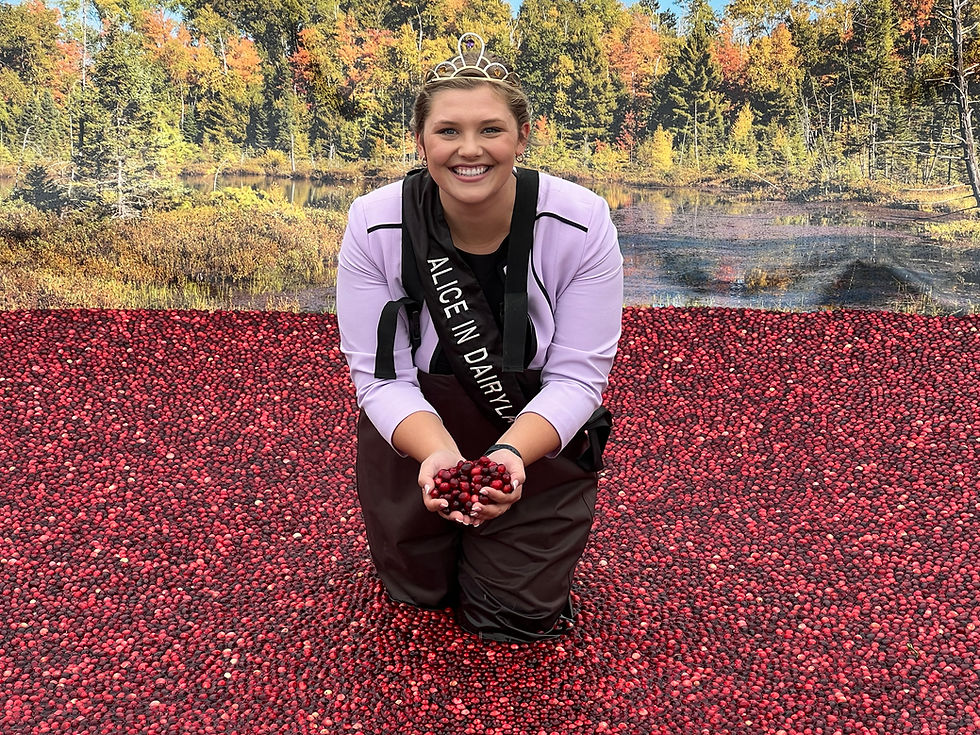Cranberries won’t BOG you down!
- Alice in Dairyland

- Oct 28, 2022
- 2 min read

In Wisconsin, cranberries are a big deal. These tart berries have a rich history that dates back to the first Thanksgiving in 1621. Native Americans used cranberries for food, various medicines, and as a beautiful dye. While we might not use cranberries to treat the common cold, cranberries are making a big splash in many other ways.
Wisconsin is known for its rich history of producing a safe, wholesome, and secure food supply for families, the nation, and the world. Cranberries are now in the spotlight as the fall harvest begins, decorating the landscape with pops of bright red color. The cranberry was discovered by early settlers, who called it a “crane-berry” because its blossoms resembled the head and beak of a sandhill crane. Cranberry harvest is underway and you will see bogs around the state flooded to float these berries to the surface. Contrary to popular belief, cranberries do not grow in water. They are grown on low-lying vines in well-drained, sandy soils with a low pH. However, these cranberry marshes are established near an adequate water supply for irrigation and harvesting purposes. This water supply can also be used to protect the berries from harsh Wisconsin weather as a thin layer of water over the vines can provide frost protection in early fall.
Cranberries have quite the reputation in Wisconsin as it is our state’s number one fruit crop both in size and economic value. Our great state grows more than 63 percent of the nation’s crop, making Wisconsin the top cranberry producing state in the nation. Produced by approximately 250 farmers, cranberries are grown on 21,000 acres across 20 Wisconsin counties.
Cranberries pack a punch when it comes to supporting Wisconsin’s diverse agriculture portfolio, but also this little red berry is making a big impact globally. Wisconsin leads the nation in the export of prepared and preserved cranberries. Traveling across the world, you can find cranberry tea in China, cranberry chutney in India, and spicy cranberry salsa in Mexico.

Recently, I traveled to Monroe County for the Warrens Cranberry Festival. More than 150,000 people attend each year, and visitors travel from across the country to learn more about Wisconsin’s cranberry industry. I enjoyed hopping in the Wetherby Cranberry Marsh, helping make Cranberry Jubilee, and trying a variety of cranberry inspired foods. Who knew there were so many different ways to enjoy Wisconsin cranberries!
Not only do cranberries offer a delicious and unique flavor, but this special berry is also a low calorie, high vitamin, and high mineral fruit with great fiber content. The popularity of cranberries is increasing as we discover just how versatile this tangy, tart, and delicious little red berry is. Wisconsin’s native fruit continues to be cultivated and integrated into new food creations that excite people’s taste buds.
Whether you try them dried as a snack, in muffins, or in a sauce, there are so many tasty ways to enjoy and benefit from Wisconsin’s state fruit. I encourage you to try something new with cranberries this fall, whether you choose a new recipe or experiment with fresh cranberries, this Wisconsin treat is sure to satisfy!







































